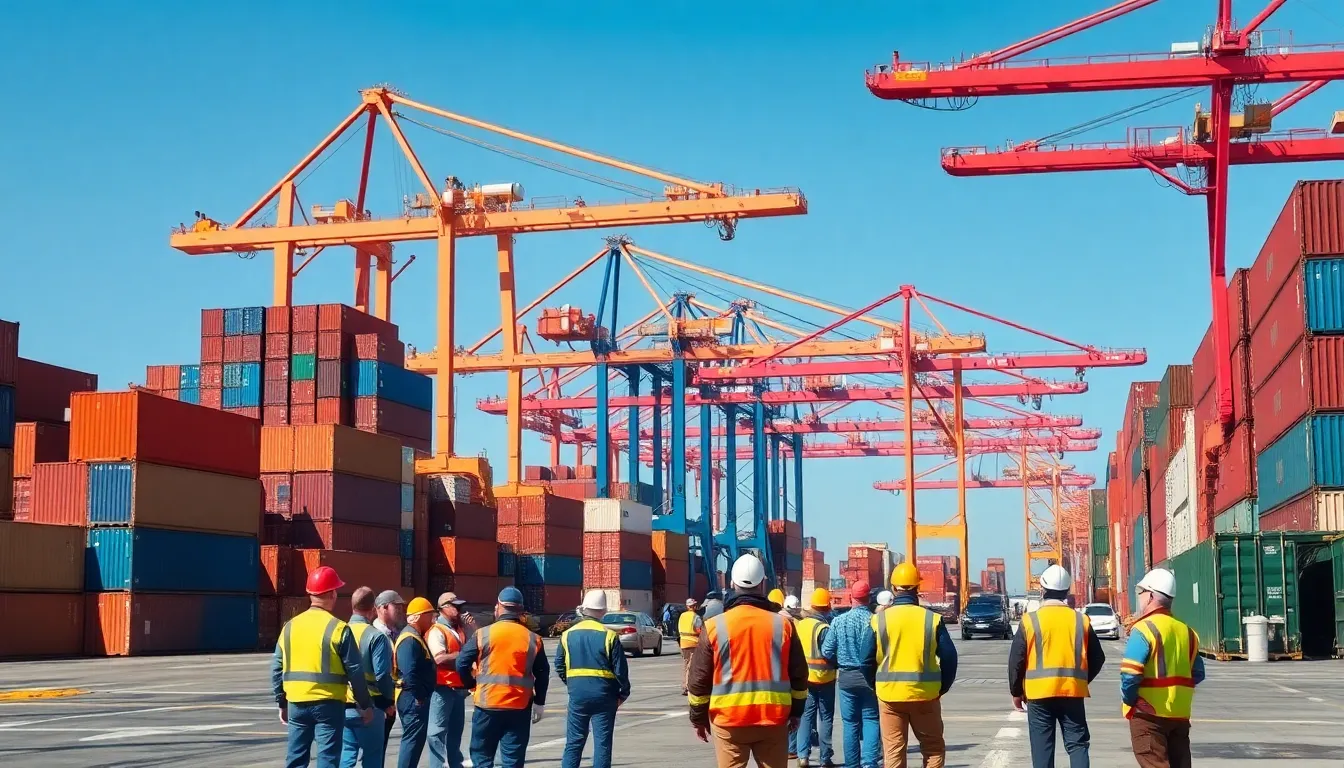In an increasingly interconnected world, global trade dynamics shape economies, influence politics, and drive innovation. As countries navigate complex relationships and shifting market demands, understanding these dynamics becomes essential for businesses and policymakers alike. The landscape of international trade is constantly evolving, driven by factors like technology, geopolitical tensions, and environmental considerations.
Emerging markets are redefining traditional trade patterns, while established economies adapt to new challenges and opportunities. The rise of digital commerce and changes in consumer behavior further complicate this intricate web of exchange. By exploring the multifaceted nature of global trade dynamics, one can gain valuable insights into the forces that shape our world today and in the future.
Table of Contents
ToggleOverview of Global Trade Dynamics
Global trade dynamics shape the framework of international commerce and influence economic growth. Trade volumes reached approximately $18 trillion in 2021, signifying the scale of interconnected markets. Factors driving these dynamics include technology, policy changes, and evolving consumer preferences.
Technology revolutionizes global trade practices. E-commerce has gained prominence, allowing businesses to reach global audiences. The rise of digital platforms like Amazon and Alibaba exemplifies how technology facilitates faster transactions and expands market access.
Geopolitical tensions introduce uncertainties in trade relationships. Trade conflicts, such as those between the U.S. and China, impact tariffs and supply chains directly. Nations adapt their strategies to mitigate risks associated with evolving geopolitical landscapes.
Emerging markets significantly alter traditional trade flows. Countries like India and Brazil are increasingly influential, presenting new opportunities for investment and collaboration. This shift requires established economies to adapt their methods of engagement.
Environmental considerations also play a role in shaping trade dynamics. Sustainable practices are becoming integral to trade policies as consumers demand more eco-friendly products. Businesses that prioritize sustainability can enhance their competitive advantage in the global market.
Consumer behavior is evolving, influencing trade patterns. Preferences for personalized products and services drive companies to innovate and adapt quickly. Understanding these trends equips businesses and policymakers to respond effectively to changing market demands.
Key Factors Influencing Global Trade

Multiple factors influence global trade, shaping its complexity and scope. Understanding these factors is essential for effective engagement in international markets.
Economic Policies
Economic policies set by governments play a crucial role in influencing global trade dynamics. Tariffs, subsidies, and trade agreements directly affect trade volumes. For instance, nations that lower tariffs foster increased import and export activities. Conversely, protectionist policies can hinder market access and slow growth. The implementation of trade agreements, such as the United States-Mexico-Canada Agreement (USMCA), stimulates trade among member countries by reducing barriers. Additionally, macroeconomic stability, characterized by inflation control and currency stability, encourages foreign investment and trade partnerships.
Technological Advancements
Technological advancements fundamentally transform global trade practices. E-commerce platforms enhance accessibility, connecting businesses with consumers worldwide. Innovations like artificial intelligence (AI) and blockchain streamline supply chains and improve transparency. For example, AI optimizes inventory management, while blockchain enhances security and traceability in transactions. Digital payment systems facilitate cross-border transactions, making international trade more efficient. Furthermore, advancements in logistics and transportation technologies expedite delivery times, making trading across borders more feasible and attractive.
Political Stability
Political stability significantly impacts global trade through creating an environment conducive to business operations. Stable governments foster investor confidence and attract foreign investments. Countries experiencing political unrest or uncertainty face challenges in trade negotiations and partnerships. Additionally, regulatory consistency encourages long-term trade relationships, while sudden changes can disrupt established practices. For instance, nations with transparent legal systems and effective governance typically enjoy higher trade volumes compared to those with frequent political upheaval.
Major Trade Agreements
Trade agreements significantly shape global trade dynamics by reducing tariffs and enhancing cross-border commerce. Two primary categories of trade agreements include regional and bilateral frameworks.
Regional Trade Agreements
Regional trade agreements (RTAs) facilitate trade between countries in a specific geographic area. Examples include the European Union (EU) and the African Continental Free Trade Area (AfCFTA).
- European Union (EU): Comprising 27 member states, the EU operates as a single market, enabling the free movement of goods, services, and people. Trade regulations harmonize standards, creating a more seamless trade environment across Europe. In 2021, the EU accounted for roughly 15% of global trade, demonstrating its extensive economic influence.
- African Continental Free Trade Area (AfCFTA): Launched in 2021, AfCFTA aims to boost intra-African trade by reducing tariffs on goods. It encompasses 54 of the 55 African Union countries, targeting a 60% increase in intra-African trade by 2022. This agreement positions Africa to enhance economic integration and competitiveness on a global scale.
Bilateral Trade Agreements
Bilateral trade agreements (BTAs) involve two countries establishing favorable trade terms. These agreements can target specific industries or products.
- United States-Mexico-Canada Agreement (USMCA): Replacing the North American Free Trade Agreement (NAFTA), USMCA enhances trade between the U.S., Mexico, and Canada. It includes provisions for digital trade, labor rights, and environmental standards, which foster a more equitable trading environment. This agreement is expected to increase economic output in the region by $68 billion.
- Comprehensive Economic and Trade Agreement (CETA): CETA, between Canada and the European Union, seeks to eliminate tariffs and improve market access. This agreement covers various sectors, including agriculture and services, and stands to increase bilateral trade by an estimated 20% over the next decade.
These major trade agreements play an essential role in defining the landscape of global trade by promoting interdependence, which can lead to economic growth and stability.
Challenges in Global Trade
Global trade faces several challenges, primarily in the form of tariffs, trade barriers, and supply chain disruptions. These obstacles impact economic interactions among nations and shape international trade practices.
Tariffs and Trade Barriers
Tariffs and trade barriers significantly influence the flow of goods between countries. Tariffs, imposed as taxes on imported goods, elevate costs for consumers and businesses. In 2021, the average global tariff rate stood at approximately 8.0%, varying by region and product type. Trade barriers, such as import quotas and strict regulatory standards, further complicate market access. Countries commonly use these measures to protect domestic industries from foreign competition. For instance, the U.S.-China trade conflict introduced numerous tariffs, affecting over $600 billion worth of goods, and disrupting traditional trade routes. Efforts to negotiate trade agreements, like the USMCA, aim to reduce these barriers, promote trade efficiency, and foster economic cooperation among member nations.
Supply Chain Disruptions
Supply chain disruptions pose ongoing challenges to global trade dynamics. Factors such as natural disasters, geopolitical tensions, and pandemics can derail the flow of goods. The COVID-19 pandemic exemplified this, as it created unprecedented delays and shortages across various industries. A survey from the Institute for Supply Management revealed that in early 2021, around 75% of companies experienced supply chain disruptions. These disruptions led to increased shipping times, rising shipping costs, and, in many cases, inflation for end consumers. Companies increasingly invest in supply chain resilience by diversifying suppliers and enhancing inventory management practices to mitigate these risks.
Future Trends in Global Trade Dynamics
Future trends in global trade dynamics will show how e-commerce and sustainability shape the landscape of international commerce. These elements are crucial for businesses to adapt and thrive in a rapidly changing environment.
Impact of E-Commerce
E-commerce is transforming global trade by expanding market reach. In 2022, global e-commerce sales approached $5.2 trillion, representing a significant portion of total retail sales. Businesses now leverage online platforms to connect with consumers across borders, altering traditional distribution channels. Digital marketplaces like Amazon and Alibaba have streamlined transactions and logistics, creating a more accessible environment for small and medium enterprises. Enhanced technologies such as artificial intelligence and big data analytics optimize supply chain management, improving efficiency and reducing costs. The rise of mobile commerce and social media integration will further catalyze innovation and demand, compelling businesses to refine their strategies to capture emerging consumer trends.
Sustainability in Trade Practices
Sustainability is becoming integral to trade practices as environmental concerns gain prominence. Companies face increasing pressure from consumers to adopt eco-friendly practices, with 66% of global consumers willing to pay more for sustainable brands in 2021. This shift influences sourcing decisions, packaging, and logistics, encouraging the adoption of circular economy principles. Initiatives such as the European Union’s Green Deal aim to make trade more sustainable by promoting lower carbon footprints and fostering clean technologies. Partnerships focused on sustainability can create competitive advantages, allowing firms to differentiate themselves in crowded markets. Adapting to sustainability demands not only aligns businesses with consumer values but also positions them favorably in future trade negotiations and regulatory frameworks.
Global trade dynamics are continuously evolving and present both challenges and opportunities for businesses and policymakers. Understanding these complexities is essential for navigating the interconnected landscape of international commerce. As emerging markets rise and technology reshapes trade practices, staying informed about trends like e-commerce and sustainability will be critical.
Adapting strategies to address geopolitical tensions and shifting consumer behaviors can enhance competitiveness in a rapidly changing environment. By embracing innovation and sustainable practices, companies can not only meet consumer demands but also position themselves for success in the future of global trade.








